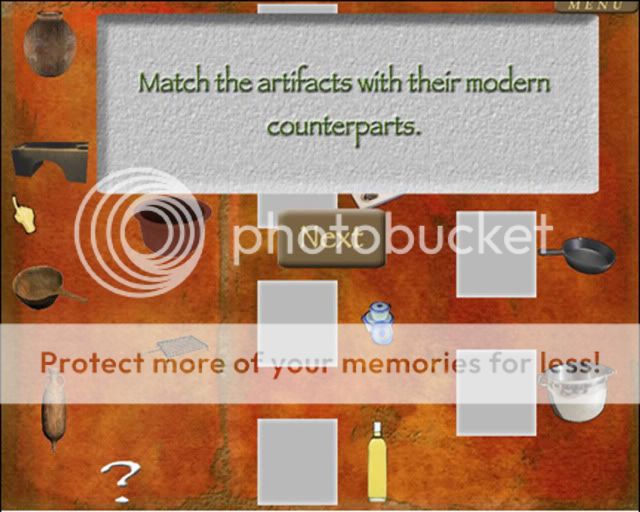After reading a few comic book-like panels to set up the story that you've been hired to help a professor oversee diggers near Pompeii, you arrive at the dig site.
Each flag represents a potential artifact. Your job is to assign diggers and their digging tools to each site. I was a little concerned when we read the instructions -- you start with six diggers and receive more as you progress, when a green bubble appears over the digger it means they've uncovered something and you have so many seconds to respond before that object is lost (balloons turn brown as a warning), different tools allow for different digging speeds and the faster diggers may damage object. I was afraid this would be too much strategy and multi-tasking for my 8 year old to handle. My advice to him was to use the slowest tools, thinking this would keep things from getting out of hand. It turns out not to be anything like a beat the clock kind of game. We had plenty of time to respond to each digger, even when two green balloons popped up at once we could get to each in turn. Clicking on the balloon gives you a close up of the ground and you control a trowel with your mouse to clear off the artifact.

As each object is uncovered, it is identified by the professor or by two young Roman children who have traveled from the past (I don't remember how they explained that one, but it's their house we're excavating). You have the opportunity to click and Learn More or return to the dig site. Of course, this is an educational game and you would be wise to take them up on their offer--the information will come in handy when the game moves on to the lab. Some of the material is repetitious--after you've read about "fineware" once, the information doesn't change.

When all the flagged sites have been excavated (and you have to wait for your diggers to finish, even if they've already found the object), the uncovered objects have to be sorted by material. You click on each object and drag it to the appropriately labeled box. If you're not sure you can get a hint (this is true with most of the learning games). Once this is done you head to the field lab. Now the learning games really begin. On the lab table are three activities using the objects you just found. You may be asked to reassemble a mosaic tile floor or a pottery jar.

It took Schnickelfritz to get used to using both mouse buttons at once to rotate and place pieces of the puzzle and the 3-d objects required Mama to step in and help. In other games like remembering where the object appeared in a room and returning them to their place it was Mama who needed help from her boy.

In this game the Hint would give you a general location, but you had to place the object exactly. Another game we played several times was comparing artifacts with their modern-day counter parts.

Looking back at the field lab picture, at ground level are options to to play calculi--like tic-tac-toe but you must get 5 in a row playing against the computer. The Room Tour let's you explore the room you've just excavated with furniture and artifacts in place. You can click the side arrows to rotate around the room. As you move your mouse around, different objects and areas will be highlighted. Clicking on them brings up the professor and the kids to teach you about the object--information you may have already read when the object was excavated. The L.E.A.R.N. quiz isn't necessarily a quiz at all, it maybe a chance to play wordsearch or hangman games with some of the new vocabulary words. The final task is the Report. This will remain locked until you at least finish all the tasks on the lab table.

You can complete this journal entry by clicking and dragging words from the list at the bottom of the page. If your selection is not correct, the words won't stick in place. This "test" is not timed and there doesn't appear to be a penalty for too many wrong guesses so your child should get it eventually. Even if I hadn't been sitting with him during the excavating and lab games, I could often figure out most words from the context of the sentence. When the report is complete and correct, you can start the whole process over by selecting another digging site--six in all.
Some other key info for Roman Town:
System Requirements
• Windows Vista/XP/2000
• CPU 800 Mhz; RAM 412MB; Hard Drive 350MB
Target Age: 8 to 88 (eight year olds may need some help reading all the text)
Price $39.95 This reflects a recent price increase. But have I got a deal for you! Homeschool Crew has been given a discount code TOS2011 good through February 21st. This will entitle you to a 20% discount off of last year's price of $24.95. This would make your final cost $19.96 plus shipping. There is a multi-user version available for classrooms ($299) and an Educator's Manual ($19.95). And they have new games in the works so check bact at their website from time to time.
If you want to see what other Homeschool Crew members think of Dig-It! games click here.


No comments:
Post a Comment